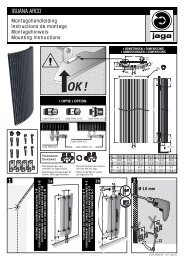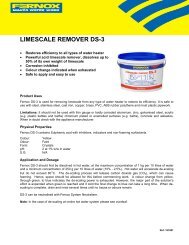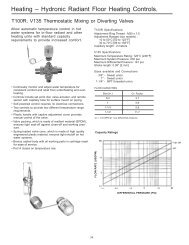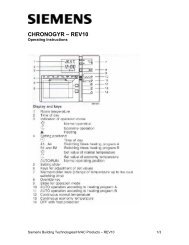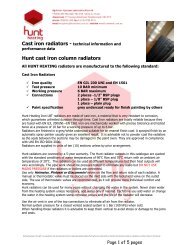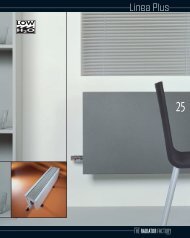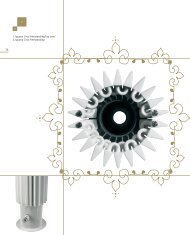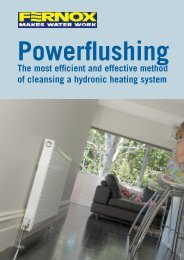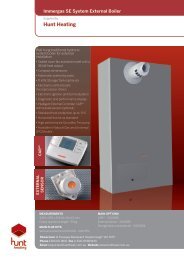Safety Data Sheet DS3
Safety Data Sheet DS3
Safety Data Sheet DS3
You also want an ePaper? Increase the reach of your titles
YUMPU automatically turns print PDFs into web optimized ePapers that Google loves.
Conforms to Regulation (EC) No. 1907/2006 (REACH), Annex II and Regulation (EC) No. 1272/2008 (CLP)<br />
SAFETY DATA SHEET<br />
DS-3 2kg<br />
1.<br />
Identification of the preparation and of the company<br />
Product name<br />
: DS-3 2kg<br />
Code : 58223<br />
Head Office<br />
: Cookson Electronics<br />
Forsyth Road<br />
Sheerwater<br />
Woking<br />
Surrey<br />
England<br />
GU21 5RZ<br />
Tel: +44(0)1483 758400<br />
Fax: +44(0)1483 728837<br />
Manufacturer<br />
: Cookson Electronics<br />
Forsyth Road<br />
Sheerwater<br />
Woking<br />
Surrey<br />
England<br />
GU21 5RZ<br />
Tel: +44(0)1483 758400<br />
Fax: +44(0)1483 728837<br />
2<br />
Contact person<br />
Material uses<br />
:<br />
shosken@cooksonelectronics.com<br />
: Water-conditioning agent.<br />
Hazards identification<br />
The product is classified as dangerous according to Directive 1999/45/EC and its amendments.<br />
Classification : Xi; R36/38<br />
R52/53<br />
Effects and symptoms<br />
Inhalation<br />
Ingestion<br />
Skin contact<br />
Eye contact<br />
Toxicity data<br />
Inhalation of dust will produce irritation to gastro-intestinal or respiratory tract,<br />
characterised by burning, sneezing and coughing.<br />
May cause burns to mouth, throat and stomach.<br />
Slightly hazardous by the following route of exposure: of skin contact (irritant).<br />
Hazardous by the following route of exposure: of eye contact (irritant).<br />
Not available.<br />
See section 11 for more detailed information on health effects and symptoms.<br />
3<br />
Composition/information on ingredients<br />
Substance/preparation<br />
Ingredient name<br />
Europe<br />
:<br />
Preparation<br />
CAS<br />
number<br />
% EC number Classification<br />
sulphamidic acid 5329-14-6 80 - 100 226-218-8 Xi; R36/38<br />
R52/53<br />
See section 16 for the full text of the R-phrases<br />
declared above<br />
Occupational exposure limits, if available, are listed in section 8.<br />
The classifications listed, indecate the potential hazards of the ingredients<br />
Date of issue : 29/07/2010. 1/8
DS-3 2kg<br />
4.<br />
First-aid measures<br />
First-aid measures<br />
Inhalation<br />
Ingestion<br />
Skin contact<br />
Eye contact<br />
Protection of first-aiders<br />
:<br />
:<br />
:<br />
:<br />
Keep person warm and at rest. If not breathing, if breathing is irregular or if<br />
respiratory arrest occurs, provide artificial respiration or oxygen by trained personnel.<br />
Get medical attention if adverse health effects persist or are severe. If unconscious,<br />
place in recovery position and get medical attention immediately. In case of<br />
inhalation of decomposition products in a fire, symptoms may be delayed. The<br />
exposed person may need to be kept under medical surveillance for 48 hours.<br />
Wash out mouth with water. Move exposed person to fresh air. Keep person warm<br />
and at rest. If material has been swallowed and the exposed person is conscious,<br />
give small quantities of water to drink. If vomiting occurs, the head should be kept<br />
low so that vomit does not enter the lungs. Never give anything by mouth to an<br />
unconscious person. Maintain an open airway. Loosen tight clothing such as a<br />
collar, tie, belt or waistband.<br />
Flush contaminated skin with plenty of water. Remove contaminated clothing and<br />
shoes. Continue to rinse for at least 10 minutes. Get medical attention. Wash<br />
clothing before reuse. Clean shoes thoroughly before reuse.<br />
Immediately flush eyes with plenty of water, occasionally lifting the upper and lower<br />
eyelids. Check for and remove any contact lenses. Continue to rinse for at least 10<br />
minutes. Get medical attention.<br />
: No action shall be taken involving any personal risk or without suitable training. It<br />
may be dangerous to the person providing aid to give mouth-to-mouth resuscitation.<br />
Notes to physician<br />
: In case of inhalation of decomposition products in a fire, symptoms may be delayed.<br />
The exposed person may need to be kept under medical surveillance for 48 hours.<br />
See section 11 for more detailed information on health effects and symptoms.<br />
5.<br />
Fire-fighting measures<br />
Extinguishing media<br />
Suitable :<br />
Not suitable :<br />
Special exposure hazards<br />
Hazardous combustion<br />
products<br />
Special protective<br />
equipment for fire-fighters<br />
:<br />
:<br />
:<br />
Use an extinguishing agent suitable for the surrounding fire.<br />
None known.<br />
No specific fire or explosion hazard.<br />
Promptly isolate the scene by removing all persons from the vicinity of the incident if<br />
there is a fire. No action shall be taken involving any personal risk or without suitable<br />
training. This material is harmful to aquatic organisms. Fire water contaminated with<br />
this material must be contained and prevented from being discharged to any<br />
waterway, sewer or drain.<br />
Decomposition products may include the following materials:<br />
carbon dioxide<br />
carbon monoxide<br />
nitrogen oxides<br />
sulfur oxides<br />
Fire-fighters should wear appropriate protective equipment and self-contained<br />
breathing apparatus (SCBA) with a full face-piece operated in positive pressure<br />
mode.<br />
6. Accidental release measures<br />
Personal precautions<br />
Environmental precautions<br />
: No action shall be taken involving any personal risk or without suitable training.<br />
Evacuate surrounding areas. Keep unnecessary and unprotected personnel from<br />
entering. Do not touch or walk through spilt material. Provide adequate ventilation.<br />
Wear appropriate respirator when ventilation is inadequate. Put on appropriate<br />
personal protective equipment (see section 8).<br />
:<br />
Avoid dispersal of spilt material and runoff and contact with soil, waterways, drains<br />
and sewers. Inform the relevant authorities if the product has caused environmental<br />
pollution (sewers, waterways, soil or air). Water polluting material.<br />
Date of issue : 29/07/2010. 2/8
DS-3 2kg<br />
6. Accidental release measures<br />
Large spill :<br />
Small spill :<br />
Move containers from spill area. Approach the release from upwind. Prevent entry<br />
into sewers, water courses, basements or confined areas. Vacuum or sweep up<br />
material and place in a designated, labelled waste container. Dispose of via a<br />
licensed waste disposal contractor. Note: see section 1 for emergency contact<br />
information and section 13 for waste disposal.<br />
Move containers from spill area. Vacuum or sweep up material and place in a<br />
designated, labelled waste container. Dispose of via a licensed waste disposal<br />
contractor.<br />
7.<br />
Handling and storage<br />
Handling<br />
Storage<br />
:<br />
:<br />
Put on appropriate personal protective equipment (see section 8). Eating, drinking<br />
and smoking should be prohibited in areas where this material is handled, stored and<br />
processed. Workers should wash hands and face before eating, drinking and<br />
smoking. Do not ingest. Avoid contact with eyes, skin and clothing. Keep in the<br />
original container or an approved alternative made from a compatible material, kept<br />
tightly closed when not in use. Empty containers retain product residue and can be<br />
hazardous. Do not reuse container.<br />
Store in accordance with local regulations. Store in original container protected from<br />
direct sunlight in a dry, cool and well-ventilated area, away from incompatible<br />
materials (see section 10) and food and drink. Keep container tightly closed and<br />
sealed until ready for use. Containers that have been opened must be carefully<br />
resealed and kept upright to prevent leakage. Do not store in unlabelled containers.<br />
Use appropriate containment to avoid environmental contamination.<br />
Packaging materials<br />
Recommended<br />
: Use original container.<br />
8. Exposure controls/personal protection<br />
Exposure limit values<br />
Ingredient name<br />
Europe<br />
No exposure limit value known.<br />
Occupational exposure limits<br />
Sweden<br />
No exposure limit value known.<br />
Denmark<br />
No exposure limit value known.<br />
Norway<br />
No exposure limit value known.<br />
France<br />
No exposure limit value known.<br />
Netherlands<br />
No exposure limit value known.<br />
Germany<br />
No exposure limit value known.<br />
Finland<br />
No exposure limit value known.<br />
United Kingdom (UK)<br />
Not available.<br />
Not available.<br />
Austria<br />
No exposure limit value known.<br />
Switzerland<br />
Date of issue : 29/07/2010. 3/8
DS-3 2kg<br />
8. Exposure controls/personal protection<br />
No exposure limit value known.<br />
Belgium<br />
No exposure limit value known.<br />
Spain<br />
No exposure limit value known.<br />
Turkey<br />
No exposure limit value known.<br />
Czech Republic<br />
No exposure limit value known.<br />
Ireland<br />
No exposure limit value known.<br />
Italy<br />
No exposure limit value known.<br />
Estonia<br />
No exposure limit value known.<br />
Lithuania<br />
No exposure limit value known.<br />
Slovakia<br />
No exposure limit value known.<br />
Hungary<br />
No exposure limit value known.<br />
Poland<br />
No exposure limit value known.<br />
Slovenia<br />
No exposure limit value known.<br />
Latvia<br />
No exposure limit value known.<br />
Greece<br />
No exposure limit value known.<br />
Portugal<br />
No exposure limit value known.<br />
Recommended monitoring<br />
procedures<br />
Exposure controls<br />
Occupational exposure<br />
controls<br />
:<br />
If this product contains ingredients with exposure limits, personal, workplace<br />
atmosphere or biological monitoring may be required to determine the effectiveness<br />
of the ventilation or other control measures and/or the necessity to use respiratory<br />
protective equipment. Reference should be made to European Standard EN 689 for<br />
methods for the assessment of exposure by inhalation to chemical agents and<br />
national guidance documents for methods for the determination of hazardous<br />
substances.<br />
: No special ventilation requirements. Good general ventilation should be sufficient to<br />
control worker exposure to airborne contaminants. If this product contains<br />
ingredients with exposure limits, use process enclosures, local exhaust ventilation or<br />
other engineering controls to keep worker exposure below any recommended or<br />
statutory limits.<br />
Date of issue : 29/07/2010. 4/8
DS-3 2kg<br />
8. Exposure controls/personal protection<br />
Hygiene measures :<br />
Respiratory protection :<br />
Hand protection<br />
Eye protection<br />
Skin protection<br />
Environmental exposure<br />
controls<br />
9.<br />
:<br />
:<br />
:<br />
Wash hands, forearms and face thoroughly after handling chemical products, before<br />
eating, smoking and using the lavatory and at the end of the working period.<br />
Appropriate techniques should be used to remove potentially contaminated clothing.<br />
Wash contaminated clothing before reusing. Ensure that eyewash stations and<br />
safety showers are close to the workstation location.<br />
Respirator selection must be based on known or anticipated exposure levels, the<br />
hazards of the product and the safe working limits of the selected respirator.<br />
Recommended:None assigned.<br />
Chemical-resistant, impervious gloves complying with an approved standard should<br />
be worn at all times when handling chemical products if a risk assessment indicates<br />
this is necessary.
DS-3 2kg<br />
11. Toxicological information<br />
Target organs<br />
: Contains material which may cause damage to the following organs: skin, eyes.<br />
12. Ecological information<br />
Aquatic ecotoxicity<br />
Product/ingredient name Test Result<br />
Species<br />
sulphamidic acid - Acute LC50<br />
70300 to 84000<br />
ug/L Fresh water<br />
Fish - Fathead<br />
minnow -<br />
Pimephales<br />
promelas - 0.3 to<br />
1 g<br />
- Acute LC50<br />
14200 ug/L Fresh<br />
water<br />
Fish - Fathead<br />
minnow -<br />
Pimephales<br />
promelas<br />
Exposure<br />
96 hours<br />
96 hours<br />
Biodegradability<br />
Other adverse effects<br />
AOX<br />
13.<br />
Disposal considerations<br />
Methods of disposal<br />
European waste catalogue<br />
(EWC)<br />
Hazardous waste :<br />
14.<br />
ADR/RID Class<br />
: No known significant effects or critical hazards.<br />
: The product contains organically bound halogens and can contribute to the AOX<br />
value in waste water.<br />
:<br />
:<br />
The generation of waste should be avoided or minimised wherever possible. Empty<br />
containers or liners may retain some product residues. This material and its<br />
container must be disposed of in a safe way. Dispose of surplus and non-recyclable<br />
products via a licensed waste disposal contractor. Disposal of this product, solutions<br />
and any by-products should at all times comply with the requirements of<br />
environmental protection and waste disposal legislation and any regional local<br />
authority requirements. Avoid dispersal of spilt material and runoff and contact with<br />
soil, waterways, drains and sewers.<br />
16 03 03* inorganic wastes containing dangerous substances<br />
Yes.<br />
International transport regulations<br />
Regulatory<br />
information<br />
Transport information<br />
UN number<br />
2967<br />
Proper shipping<br />
name<br />
Sulphamic acid<br />
(sulphamidic acid)<br />
Classes<br />
8 III<br />
PG* Label<br />
Additional<br />
information<br />
Hazard identification<br />
number<br />
80<br />
CEFIC Tremcard<br />
80GC9-III<br />
IMDG Class<br />
2967<br />
Sulphamic acid<br />
(sulphamidic acid)<br />
8 -<br />
Emergency<br />
schedules (EmS)<br />
F-A, S-B<br />
Date of issue : 29/07/2010. 6/8
DS-3 2kg<br />
14. Transport information<br />
IATA Class 2967 Sulphamic acid 8 III<br />
(sulphamidic acid)<br />
Passenger and<br />
Cargo Aircraft<br />
Quantity limitation:<br />
5 kg<br />
Cargo Aircraft Only<br />
Quantity limitation:<br />
60 kg<br />
PG* : Packing group<br />
15.<br />
Regulatory information<br />
EU regulations<br />
Classification and labeling have been determined according to EU Directives 67/548/EEC and 1999/45/EC<br />
(including amendments) and take into account the intended product use.<br />
Hazard symbol or symbols<br />
:<br />
Risk phrases<br />
<strong>Safety</strong> phrases<br />
Product use<br />
:<br />
:<br />
:<br />
Irritant<br />
R36/38- Irritating to eyes and skin.<br />
R52/53- Harmful to aquatic organisms, may cause long-term adverse effects in the<br />
aquatic environment.<br />
S2- Keep out of the reach of children.<br />
S26- In case of contact with eyes, rinse immediately with plenty of water and seek<br />
medical advice.<br />
S28- After contact with skin, wash immediately with plenty of water.<br />
S61- Avoid release to the environment. Refer to special instructions/safety data<br />
sheet.<br />
Consumer applications, Industrial applications.<br />
Germany<br />
Hazard class for water<br />
Technical instruction on<br />
air quality control<br />
Italy<br />
Emission control directive :<br />
16.<br />
History<br />
Other information<br />
Full text of R-phrases referred to in<br />
sections 2 and 3 - Europe<br />
Full text of classifications referred<br />
to in sections 2 and 3 - Europe<br />
Date of printing<br />
:<br />
nwg Appendix No. 4<br />
: TA-Luft Number 5.2.1: 95.1%<br />
Not classified.<br />
31/08/2010.<br />
Date of issue<br />
: 29/07/2010.<br />
Date of previous issue : 28/07/2010.<br />
Version<br />
Prepared by<br />
:<br />
:<br />
:<br />
:<br />
:<br />
R36/38- Irritating to eyes and skin.<br />
R52/53- Harmful to aquatic organisms, may cause long-term adverse effects in the<br />
aquatic environment.<br />
Xi - Irritant<br />
5<br />
Simon Hosken<br />
Environmental, Health and <strong>Safety</strong> Manager<br />
Indicates information that has changed from previously issued version.<br />
References<br />
Date of issue : 29/07/2010. 7/8
DS-3 2kg<br />
16.<br />
Other information<br />
The Health and <strong>Safety</strong> At Work Act 1974, section 6.<br />
Control of Substances Hazardous to Health (CoSHH) Regulations 2002 and its amendments.<br />
Preparation contains soley TSCA and REACh 1907/2006 listed substances.<br />
This safety data sheet has been prepared in accordance with the requirements of the Chemicals (Hazard<br />
Information and Packaging for Supply) Regulations 2002 which implement EC Directives 1999/45/EC and<br />
2001/58/EC and their amendments.<br />
Notice to reader<br />
To the best of our knowledge, the information contained herein is accurate. However, neither the abovenamed<br />
supplier, nor any of its subsidiaries, assumes any liability whatsoever for the accuracy or<br />
completeness of the information contained herein.<br />
Final determination of suitability of any material is the sole responsibility of the user. All materials may<br />
present unknown hazards and should be used with caution. Although certain hazards are described herein,<br />
we cannot guarantee that these are the only hazards that exist.<br />
Date of issue : 29/07/2010. 8/8



